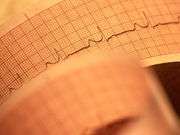Exercise stress ECG underutilized as initial test for suspected CAD

(HealthDay)—Exercise stress electrocardiography (ExECG) can yield substantial data from risk stratification in suspected or known coronary artery disease, according to a state-of-the-art paper published in the Nov. 1 issue of JACC: Cardiovascular Imaging.
Jamieson M. Bourque, M.D., M.H.S., and George A. Beller, M.D., from the University of Virginia Health System in Charlottesville, discuss the value of ExECG for risk stratification of suspected or known coronary artery disease.
The researchers note that variables derived from ExECG can yield considerable data from risk stratification, in addition to or without concurrent stress myocardial imaging. Markers such as ST-segment elevation in lead aVR, abnormal heart rate recovery after exercise, failure to achieve target heart rate, and poor exercise capacity can improve risk stratification of ExECG in addition to exercise-induced ischemic ST-segment depression. The prevalence of inducible ischemia was very low and prognosis excellent for patients achieving ≥10 metabolic equivalents on ExECG. In higher risk populations, cardiac imaging techniques add diagnostic and prognostic value.
"Optimal test selection for symptomatic patients with suspected coronary artery disease requires a patient-centered approach factoring in the risk/benefit ratio and cost-effectiveness," the authors write.
One author disclosed ties to Astellas Global Development.
More information: Full Text (subscription or payment may be required)
Copyright © 2015 HealthDay. All rights reserved.




















